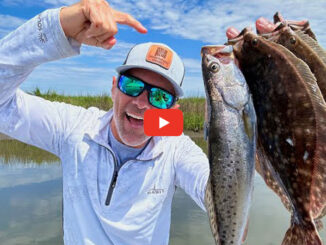
The southern flounder, Paralichthys lethostigma,is a flat, oval-shaped fish native to the Atlantic and Gulf coasts. It is the biggest of the flounder species found throughout the Atlantic and Gulf.
Commonly referred to as simply “flounder,” the southern flounder is distinguished from other flounder by the numerous dark and light spots and blotches present on the dark side. While other flounder have ringed or ocellated spots or blotches, the southern flounder’s markings do not have these characteristics.
Fisheries biologists refer to southern flounder as being “left-handed,” because when held vertically with the eyes facing forward, it’s the left side of the flounder that is dark. The right side is white. On very rare occasions, a “right-handed” flounder is caught. Also, on very rare occasions, the white side can be either as dark as the other or be partially brown.

Southern flounder spend most of their lives in estuaries, rivers and shallow, coastal waters, including in and around the surf zone. They are most abundant in and around the mouth of tidal creeks in water with shallow, muddy bottoms. They also spend time in flooded salt marshes at high tide. Most adult southern flounder head offshore for a few months during winter.
Annual migration
Juvenile southern flounder stay in those same areas, but they stay inshore during winter until they are old enough to spawn — typically in the fish’s second or third year.
While these are saltwater fish, they sometimes venture above the saltwater dividing line and into freshwater in some rivers. They seem to tolerate freshwater fairly well and find their way back to brackish or saltwater with no trouble.
The average southern flounder is 12 to 14 inches long and weighs 1 to 2 pounds, but they can get considerably larger. Most males live about 5 years in the wild, while females often live to be between 7 and 8 years old. Females are usually larger than males simply because they outlive them.
Both male and female southern flounder begin spawning during their second or third years. By then, males are usually between 11 and 13 inches in length. Females are typically 14 to 16 inches long.
During late fall/early winter, adults head offshore to spawn. They return in the spring, usually to the same inshore waters, year after year.
Flounder larvae spend their first 60 days traveling ocean of Gulf currents, which push them into inshore estuaries in late winter or early spring. As the larvae settle inshore, they change into their flat body forms.
Southern flounder are predatory fish, ambushing their prey using camouflage to blend into the muddy bottoms. Adults eat a wide variety of fishes and also shrimp and crabs. Their mouths are deceptively large, and they can eat much bigger meals than most people realize. Anglers targeting large flounder often use baits or lures that are quite large.
Anglers throughout the southeast have a few nicknames for flounder, including: fluke, flatfish, flatty, and plie (pronounced pleh).
Records
The world-record southern flounder was caught in 1983 in Florida’s Nassau Sound, by Larenza Mungin. The fish weighed 20 pounds, 9 ounces.
The Louisiana state record, caught by Gary Hargis, weighed 13.06 pounds. Hargis caught the fish East of South Pass in June 1998.
